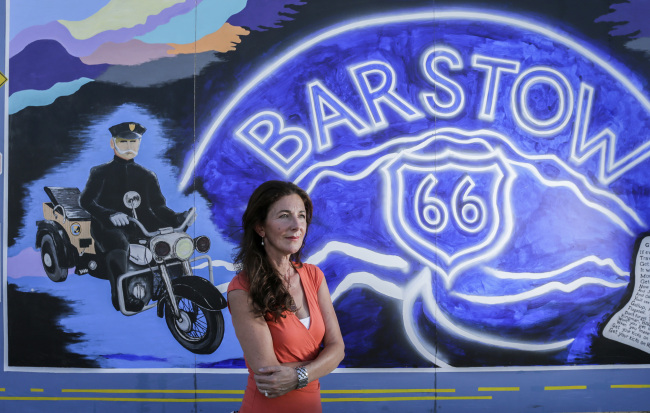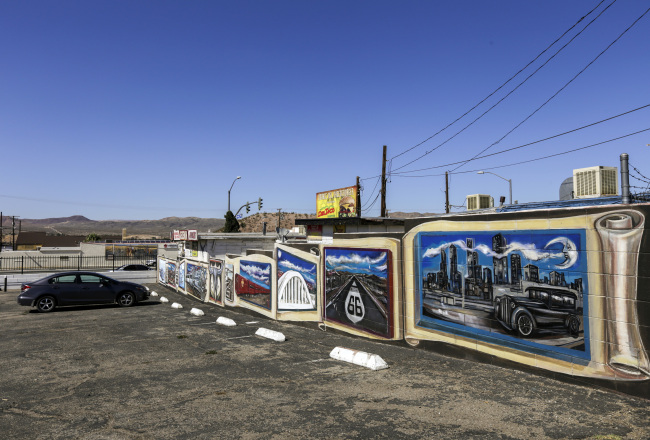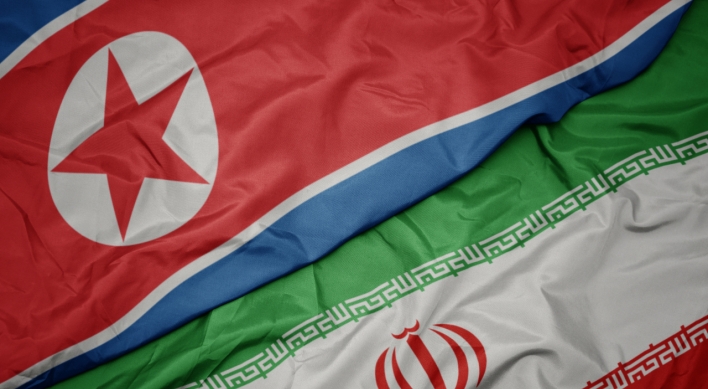On eve of Route 66’s 90th anniversary, Barstow looks to a brighter, hand-painted future
By Korea HeraldPublished : Oct. 7, 2016 - 14:16
BARSTOW, California — In the early 20th century, the small desert town of Barstow was a bustling stop on Route 66 between Los Angeles and Chicago, immortalized in a popular 1940s tune as one the places where travelers heading west could get their kicks.
Now mostly known for its excessive heat, outlet mall and as home to the nation’s oldest remaining Del Taco, Barstow has struggled in recent years with vacant storefronts and dirt lots dominating an iconic portion of its historic Main Street, which has been bypassed as a key east-west thoroughfare by U.S. interstate routes such as I-15.
But civic leaders want to return Barstow’s main street to the beaten path, and they are betting that nostalgia for an earlier era of American car culture and pop kitsch will lure road travelers and their dollars.
As the 90th anniversary of Route 66 approaches in November, the city is pinning its hopes on a downtown revitalization plan that may infuse this 8-kilometer stretch of road with new building facades, signage and pedestrian amenities.
The city also wants to highlight its identity as a mural town, one of dozens of small California communities that are reproducing local history and culture through colorful murals, frequently painted on the sides of prominent buildings.
Now mostly known for its excessive heat, outlet mall and as home to the nation’s oldest remaining Del Taco, Barstow has struggled in recent years with vacant storefronts and dirt lots dominating an iconic portion of its historic Main Street, which has been bypassed as a key east-west thoroughfare by U.S. interstate routes such as I-15.
But civic leaders want to return Barstow’s main street to the beaten path, and they are betting that nostalgia for an earlier era of American car culture and pop kitsch will lure road travelers and their dollars.
As the 90th anniversary of Route 66 approaches in November, the city is pinning its hopes on a downtown revitalization plan that may infuse this 8-kilometer stretch of road with new building facades, signage and pedestrian amenities.
The city also wants to highlight its identity as a mural town, one of dozens of small California communities that are reproducing local history and culture through colorful murals, frequently painted on the sides of prominent buildings.

“There’s a great collaboration that is going on at the moment … to lift up the community, focus on the Route 66 identity (and) celebrate Barstow and the region’s rich culture and heritage,” said Jane Laraman-Brockhurst, the former president of Main Street Murals, which commemorates the city’s history and promotes tourism through the hand-painted artwork.
Named after William Barstow Strong, the former president of the Atchison, Topeka and Santa Fe Railway, Barstow was founded next to Daggett and Calico Hills, which were the site of silver and borax mines in the late 19th and early 20th centuries.
Barstow “was the place to stock up before you went to Las Vegas, which was an arduous trip back in the 1930s,” said local historian Steve Smith.
Smith said early motorists often stopped at Barstow’s Harvey House — built in 1911 as a boarding house and dining room for train passengers — and sent telegrams to Las Vegas before hitting the road. He said the telegrams were used by authorities to keep an eye out for motorists and search for them somewhere in the desert if they didn’t arrive in Las Vegas on time.
As the years passed, Smith said, Barstow grew into a gateway for trains and automobiles. The railyard — a maze of tracks situated just a half-mile north of Main Street — is still used by commercial train operators.
However, times have changed.

Through the fiscal year ending in 2015, the city’s biggest employers were the nearby Fort Irwin National Training Center, a Marine Corps Logistics Base and the BNSF Railroad.
The town has struggled economically, with a median household income nearly $14,000 lower than the county average of $54,100, according to census records.
But Barstow is hoping the new plan, recently approved by the City Council, will help revitalize downtown.
Possible improvements include revamped storefronts, neon signs and trees providing much-needed shade.
“What this plan will do is give prospective property buyers a clearer idea for the city’s vision of the downtown area,” said Gaither Loewenstein, the city’s economic development and planning manager.
One obstacle is funding, Loewenstein said. City planners are hoping most of that will come from private investment.
In conjunction with the plan, the city is hoping to install eight car-themed road signs soon, Loewenstein said.
Laraman-Brockhurst, now director of the Desert Discovery Center, is promoting several Route 66-themed events, including an Oct. 15 festival where the next mural will be unveiled.
Since 1997, about two dozen murals have been hand painted, with subjects such as the California Gold Rush, Barstow’s historical Harvey House and the “Mojave Runners,” a group of Native Americans who ran up to 100 miles a day to share messages between villages.
She said there are plans to add Route 66 signage to promote the area, in addition to cleanup efforts before the October festival.
Adorned with a leather, Indiana Jones-style hat and gold-rimmed sunglasses, Smith, the historian, is optimistic about the city’s future. When showing people around, he keeps a short stack of index cards in a blue case containing notes, facts and jokes about the murals — interrupted only when he stops to pick up trash along the city’s Main Street or wave to a friendly face.
Smith was planning a “Pokemon Go” themed mural tour in September, aimed at broadening the tour’s appeal. He wants to increase the number of murals and for more businesses to move in on Main Street, which has been on the losing end of business ever since more traffic began flowing on I-15 instead of Route 66, he said.

He cites Barstow’s connection to Native Americans, early pioneers and Route 66 as evidence the city is at an important cultural crossroads.
“This is our history,” he said. “Instead of writing it in a book, we’re writing it in pictures.”
Property owners such as Sandy Baca and her husband, Fred, who have seen business come and go, said they are eager for renewal.
Their building, which once housed a dance studio and Xerox office, has sat vacant for a few months and recently fell victim to vandals who removed two life-size wooden figures — representing local personalities and celebrities — that were positioned in front of the mural alongside her building. The figures haven’t been recovered, but Baca hopes to erect new ones before the Route 66 festival in October.
Baca supports the plan being pushed by the city, and she wants to see more promotion of the murals, in addition to more Route 66 signage and help for small businesses.
“When you have a community that really cares as much about itself as Barstow does, I think you see more things coming again,” Baca said. “I don’t see (Barstow) dying. It will revive itself again.”
(Tribune Content Agency)
By Shane Newell
Los Angeles Times
-
Articles by Korea Herald


![[Exclusive] Korean military set to ban iPhones over 'security' concerns](http://res.heraldm.com/phpwas/restmb_idxmake.php?idx=644&simg=/content/image/2024/04/23/20240423050599_0.jpg&u=20240423183955)

![[Graphic News] 77% of young Koreans still financially dependent](http://res.heraldm.com/phpwas/restmb_idxmake.php?idx=644&simg=/content/image/2024/04/22/20240422050762_0.gif&u=)



![[Pressure points] Leggings in public: Fashion statement or social faux pas?](http://res.heraldm.com/phpwas/restmb_idxmake.php?idx=644&simg=/content/image/2024/04/23/20240423050669_0.jpg&u=)










